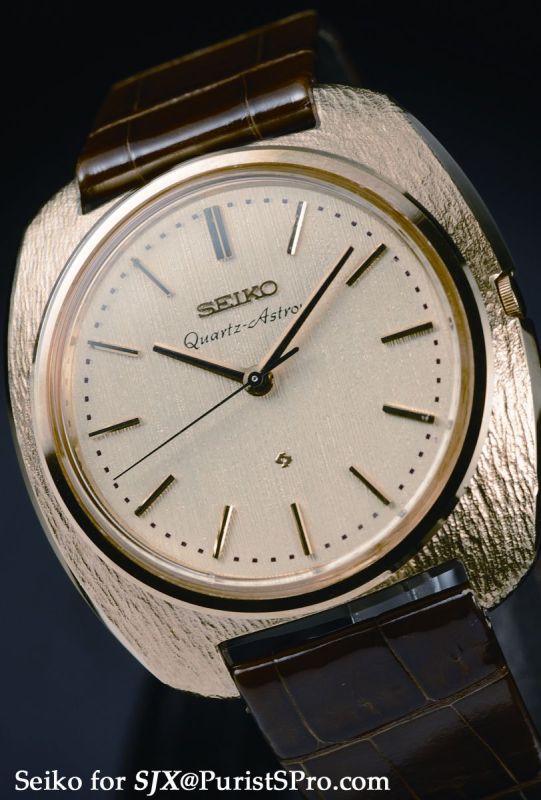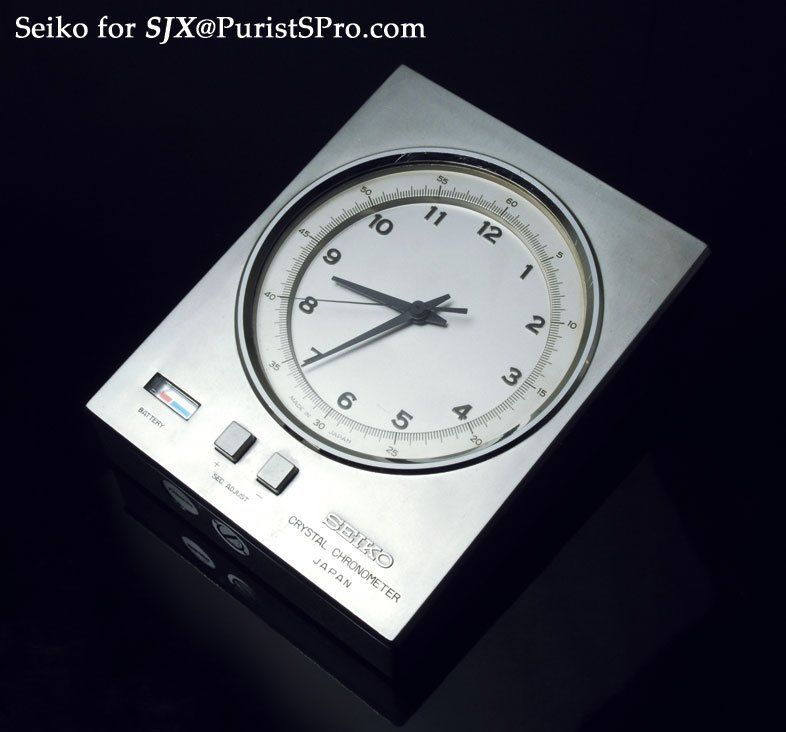
SJX
[Purist]
8540

Press release: Seiko celebrates the 40th anniversary of the quartz movement
Press release:
The SEIKO Quartz Astron,
the watch that changed the way the world told time.

December 25, 1969. The SEIKO Quartz Astron, the world’s first quartz watch
The 40th Anniversary of quartz
In December 2009, SEIKO starts a year of celebrations marking the 40th anniversary of the launch of the world's first quartz watch, the SEIKO Quartz Astron.
This important anniversary is being celebrated in a variety of ways, starting with an exhibition in December in Tokyo of 40 new designs, all inspired by the Quartz Astron. The exhibition will be followed by the release, at Baselworld 2010, of revolutionary quartz watches whose new functionality and design demonstrates the great future potential of this most important of watchmaking technologies.
The SEIKO Power Design Project exhibition took place from December 1 to 6 in Tokyo's fashionable and trend-setting district of Omotesando, and the 40 designs featured add a contemporary twist to the original Quartz Astron design. The SEIKO designers preserved the integrity of the iconic Quartz Astron design, but brought it up to date for the next generation of watch enthusiasts.
Project 59A
It all started in 1959 as 'Project 59A' within the Research & Development laboratory in Suwa Seikosha (now known as SEIKO Epson), one of the SEIKO Group's watchmaking companies. It had been known since the days of Pierre Curie's experiments in 1880 that , when an electrical current is passed across a quartz crystal, the crystal would vibrate at a fast and very precise speed. The question was how to utilise this effect in a practical application. In 1927, Warren Morrison, a technician in Bell Laboratories in the USA was the first to demonstrate that accurate time could be measured using the 'piezo-electric' effect, and SEIKO built, in late 1959, a quartz clock that was successfully used in Japan by a radio and TV station. However, this clock was huge, 2.1 meters high and 1.3 meters wide ! To develop a watch using the same technology must have seemed to the engineers on Project 59A like an insurmountable challenge. Nevertheless, the project was launched.

The 1959 quartz clock
The first results
By 1962, SEIKO had succeeded in downsizing to build a quartz marine chronometer for Japan's shipping industry but it still weighed 30 kilos. A further advance was made in the following year when a portable quartz timer was created for sports applications. It weighed just three kilos, and became the first quartz device ever used at Olympic Games when it was used as a back-up timer at the longer athletics events at the Tokyo Olympics in 1964. This device, the QC-951, was put on the market and sold for 125,000 Japanese Yen (USD 347 at the 1959 rate).
The daunting challenge of miniaturisation

The Crystal Chronometer QC-951 used to time events at the 1964 Tokyo Olympic Games
The QC-951 had proven that a stable and reliable quartz timer could be made portable. However, the challenge of further miniaturisation remained. The QC-951 had an exterior volume of 1760 cubic centimetres, while a viable watch movement needed to be 3.74cc.
So, every part needed to be miniaturised. The key advance was the creation of an open-style stepping motor, which made significant size reduction possible. The power requirement of the quartz movement also had to be reduced, so that a miniature battery could be used. To make this possible, SEIKO’s engineers invented new IC’s, first a hybrid type and, soon after, a C-MOS IC. These advances made possible a movement that could run for more than one year on a button-type battery.
The quartz revolution takes off
The limited edition Quartz Astron was presented in an 18 carat gold case and went on sale in Tokyo on December 25, 1969 in a limited edition of just 100. It was a momentous day for the entire watch industry as it was clear to all that, with further advances in efficiency, quartz would deliver far greater accuracy than any mechanical watch could ever achieve. The Quartz Astron was precise to five seconds a month, 100 times more accurate than any existing watch.
And, in the coming years, it was SEIKO that made nearly all of these advances. In 1973, SEIKO launched the world's first LCD quartz watch with a six-digit display. In 1975, a multi-function LCD quartz watch was launched, bringing high accuracy to the chronograph. In 1983, SEIKO created an analogue quartz chronograph and, in 1988, SEIKO combined the best of automatic and electronic watchmaking to create A.G.S. (now known as Kinetic). Powered by the movement of the wearer, it converted kinetic energy into the electricity required to run the quartz regulated movement.
Perhaps more important than all these SEIKO innovations was the decision in the early 70's to open all SEIKO's many quartz patents to the world. Still today, most quartz watches use the design and technologies that SEIKO made available.
As the fifth decade of quartz begins
The 40th anniversary of quartz is for SEIKO much more than a moment to review past achievements. It is an opportunity to look to the future.
The progress made by quartz-based timepieces over the past 40 years has been astonishing and SEIKO's leadership in electronic watchmaking is itself a cause for celebration. However, quartz technology is an infinitely flexible springboard for future innovation and SEIKO will continue to develop new designs and new functionalities on the quartz platform in the coming years.
As the fifth decade of quartz opens in 2010, SEIKO will provide various dramatic and exciting products, proving the future potential of quartz technology at Baselworld 2010.
This message has been edited by SJX on 2009-12-09 09:24:21

Press release: Seiko celebrates the 40th anniversary of the quartz movement

Interesting enough. perhaps Seiko will unveil new watches..
